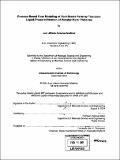| dc.contributor.advisor | Samuel Allen. | en_US |
| dc.contributor.author | Barradas Martinez, Juan Alfredo, 1974- | en_US |
| dc.contributor.other | Massachusetts Institute of Technology. Dept. of Materials Science and Engineering. | en_US |
| dc.date.accessioned | 2005-09-27T18:47:21Z | |
| dc.date.available | 2005-09-27T18:47:21Z | |
| dc.date.copyright | 2004 | en_US |
| dc.date.issued | 2004 | en_US |
| dc.identifier.uri | http://hdl.handle.net/1721.1/28869 | |
| dc.description | Thesis (M. Eng.)--Massachusetts Institute of Technology, Dept. of Materials Science and Engineering, 2004. | en_US |
| dc.description | Includes bibliographical references (leaves 74-75). | en_US |
| dc.description.abstract | (cont.) cost between these two processes was related mainly to their powder scrap rates, 15 % for the Pressing-TLI and 80% for the 3DP-TLI. The high scrap rate value of the 3DP process originates from the fact that powder is sieved before printing, eliminating the coarse and very fine particles. A possible option to decrease this value is to recycle or sell the extra powder, which will reduce the fabrication cost significantly. The model also shows that the main cost for both processes is the powder cost. TLI technical parameters such as heating and cooling rates were included in the model in order to predict the cost behavior when those are manipulated. Because the powder cost dominates the total fabrication cost, variations in the heating and cooling rates do not significantly affect the cost. | en_US |
| dc.description.abstract | Tool steels are iron-based alloys that are melted and processed to develop characteristics useful in the working and shaping of other metals. Tools for such processes must withstand high loads without breaking and without undergoing excessive wear or deformation. Fabrication of direct tool steel parts with complex geometry is possible using Transient Liquid-Phase Infiltration (TLI) in conjunction with Three-Dimensional Printing (3DP). Tool steel parts can also be manufactured using TLI in combination with Cold Powder Methods such as Uniaxial Pressing. Both approaches produce a final part of homogenous composition without significant dimensional change, offering advantages over-traditional infiltration and full-density sintering [1]. Now that the expertise in the TLI has been developed in the MIT laboratories, an economic evaluation represents a complementary action for introducing TLI in the commercial market of Rapid Prototyping and Powder Metallurgy. A process-based cost model was developed to describe and measure the performance of the 3DP-TLI and Pressing-TLI combined processes. Operating conditions such as cycle time, material cost, labor cost, production volume and financial parameters were introduced into the model in order to calculate a total fabrication cost per part. Different charts showing cost behaviors and their relations with production volume, batch size, effectiveness in the powder utilization, and weight of the part are presented. The results show that the optimum point in the cost-production volume curve was located at 13,000 parts per year with a fabrication cost of $19.90 per part, for the Pressing-TLI case, and $61.73 per part for the 3DP-TLI alternative (based on a one-half pound D2 tool steel part). The difference in cost | en_US |
| dc.description.statementofresponsibility | by Juan Alfredo Barradas Martinez. | en_US |
| dc.format.extent | 75 leaves | en_US |
| dc.format.extent | 5560243 bytes | |
| dc.format.extent | 5567971 bytes | |
| dc.format.mimetype | application/pdf | |
| dc.format.mimetype | application/pdf | |
| dc.language.iso | en_US | |
| dc.publisher | Massachusetts Institute of Technology | en_US |
| dc.rights | M.I.T. theses are protected by copyright. They may be viewed from this source for any purpose, but reproduction or distribution in any format is prohibited without written permission. See provided URL for inquiries about permission. | en_US |
| dc.rights.uri | http://dspace.mit.edu/handle/1721.1/7582 | |
| dc.subject | Materials Science and Engineering. | en_US |
| dc.title | Process-based cost modeling of tool-steels parts by transient liquid-phase infiltration of powder-metal preforms | en_US |
| dc.type | Thesis | en_US |
| dc.description.degree | M.Eng. | en_US |
| dc.contributor.department | Massachusetts Institute of Technology. Department of Materials Science and Engineering | |
| dc.identifier.oclc | 60425127 | en_US |
